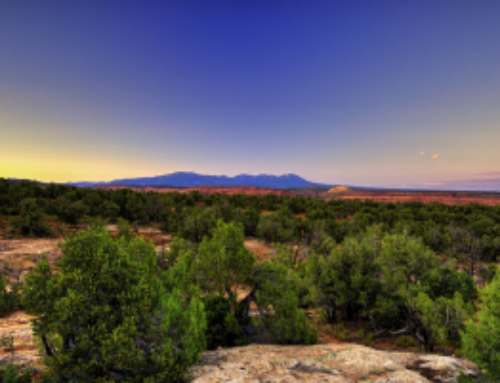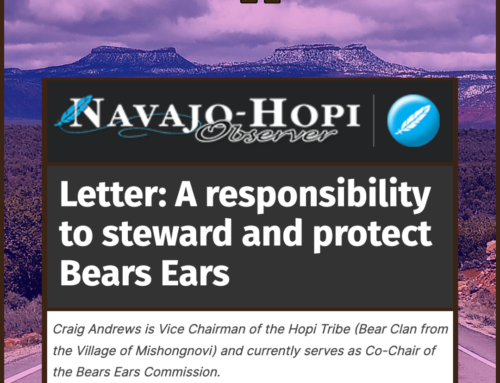By Navajo Times | May 2, 2024 | Opinion |
By Curtis Yanito and Davina Smith
The Bears Ears National Monument, known in Diné bizaad as Shash Jaa’, holds profound significance for the Navajo people, serving as a living testament to our rich heritage and deep ties to the Bears Ears region.
Our oral traditions, supported by archaeological and historical evidence, document our enduring presence in and around Bears Ears. Places such as the iconic Bears Ears buttes, Elk Ridge, and Comb Ridge are not mere geographical features; they are sacred places where ceremonies have been performed for generations, ensuring the health and continuity of our community.
The entire landscape is imbued with the footprints of our ancestors, resonating with prayers, offerings, and the echoes of the ancient ones. This sacred landscape is woven with the stories and practices of our people and embodies our identity and spiritual connection to the earth. As such, it demands our respect and protection.
That’s why the Navajo Nation, Hopi Tribe, Zuni Tribe, Ute Indian Tribe, and Ute Mountain Ute Tribe stand in unity as the Bears Ears Commission to protect this living cultural landscape. In partnership with the Bureau of Land Management and the U.S. Forest Service, the Commission has provided management recommendations rooted in our Traditional Indigenous Knowledge (TIK) and our long history of land stewardship.
The newly released draft Resource Management Plan (RMP) for Bears Ears National Monument reflects our expertise in sustainable resource management. Alternative E of the draft plan aligns most closely with our tribal values and recommendations, prioritizing a management approach that respects and integrates our traditional knowledge.
We invite all community members to join the Bears Ears Commission and our federal agency partners at the forthcoming in-person meeting in Twin Arrows, Arizona. This public comment meeting will be an excellent opportunity to dive deeper into the details of the management proposal for this revered landscape, and there will be an opportunity to submit a public comment to federal agencies.
From the Abajo Mountains to Navajo Mountain and beyond, these places hold the collective memories and the spiritual essence of the Navajo people. The significance of these areas is acknowledged in ceremonies that connect the present with our past.
Historically, we utilized Bears Ears for gathering medicinal plants, harvesting foods, hunting, and ceremony. The land management practices we developed over millennia are a testament to our sustainable relationship with nature, one that modern policies could learn from. These practices demonstrate a profound understanding of the land’s ecology, an understanding born from a deep, spiritual connection to the landscape.
Today, the voices of the Navajo community are crucial in shaping the future management of Bears Ears. Our insights to this draft RMP offer valuable guidance on preserving the landscape’s integrity and continuing the traditional practices that have kept this land sacred.
We urge you to join us at Twin Arrows and show your support for the Commission’s preferred alternative, Alternative E. Your participation is vital in ensuring that our traditions, values, and connections to the land are preserved and honored in the management of Bears Ears. Together, we can safeguard this landscape for future generations, maintaining it as a living testament to our heritage, our values, and our lifeways.
The third in-person public comment meeting will be held in Twin Arrows on Monday, May 6, 2024, from 6 -8 p.m. MST. The meeting will be located at the Twin Arrows Casino Resort, 22181 Resort Boulevard, 86004
About the authors:
Curtis Yanito grew up near Bluff, Utah, and is a Navajo Nation Council delegate representing the communities of Mexican Water, Tółikan, T’iis Názbąs, Aneth, and Red Mesa. He has long been a proponent for the protection of Bears Ears and serves as the Bears Ears Commissioner for the Navajo Nation. He is Tł’ááshchí’í and born for Tódích’íi’nii. His maternal grandfather is Hashk’ąą Hadzohó, and his paternal grandfather is Tábąąhá.
Davina Smith is originally from Monument Valley, Utah, and was appointed by President Buu Nygren to represent the Navajo Nation on the Bears Ears Inter-Tribal Coalition. As a community activist she has long advocated for protection for the Bears Ears region. She belongs to the Táchii’nii clan and is born to the Tábąąhá.
Find this piece and more at the Navajo Times



